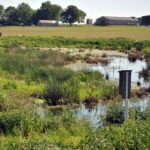Conservation Drainage
Throughout Illinois and other parts of the Midwest, farmers are increasingly investing in tile drainage systems to improve productivity and trafficability of their fields. Conservation drainage practices such as bioreactors, controlled drainage systems, saturated buffers, and constructed wetlands, are designed to capture and treat drainage from tile outlets, providing effective and often long-term nutrient loss reduction benefits.

ADMC Constructed Wetland Fact Sheet
This ADMC webpage provides information on constructed wetlands, including considerations for installation and financial impacts.
View Website
NRCS Saturated Buffer Practice Overview
This one page factsheet from NRCS provides an overview of saturated buffers, how they fuction, and common associated practices.
View Website
ADMC Saturated Buffer Fact Sheet
This ADMC webpage provides information on saturated buffers including considerations for installation and financial impacts.
View Website
SWCS Saturated Buffers
This video, in the SWCS Conservation Media Library, shows how saturated buffers serve as a nutrient removal option for farmers.
Watch Video
Illinois NREC Saturated Buffer Video
Jon Schoonover with Southern Illinois University has designed a unique Saturated Buffer configuration that he has installed and tested in Moultrie County Illinois. The project is funded by NREC in partnership with Illinois Farm Bureau, Land Improvement Contractors of America (LICA) and others.
Watch Video
IL Farm Bureau Saturated Buffer Field Day
Illinois Farm Bureau, Southern Illinois University College of Agriculture, Illinois Land Improvement Contractors Association, and USDA-NRCS partnered together to bring Illinois farmers an educational demonstration of our latest edge of field practice. Together they are striving to protect our natural resources and seeking out new ways to be better stewards of our land.
Watch Video